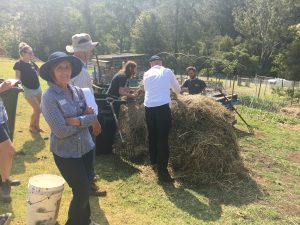At the end of last year, we shared an update on how we are expanding our regenerative farming practices at Laurel View. Long periods of drought and uncertainty has meant that regenerative and sustainable approaches, are now becoming as much a necessity, as an environmental consideration for farmers.
Regenerative farming aims to keep water in the landscape, increase the store of carbon in the ground, improve soil health and increase biodiversity. For us as farmers the main benefits are around the impact that improved soil health has on our productivity, the health of our livestock, as well as building our resilience to drought and other climatic events long-term.
Improving the overall health of the farm is my goal and how I intend to give back to the land that I was born and raised on. The impact of what we do now will be felt for years to come, as we continue to produce healthy animals and great tasting meat, with no harmful chemicals, antibiotics or fertilizers.
Biodynamic compost
Our first application of biodynamic cow manure compost is now complete. Although we already use many regenerative farming practices at Laurel View, this trial is a real opportunity for us to put something new to the test.
By making our own biodynamic compost we hope replenish and renew our soil, create healthier paddocks and higher quality feed, with fewer weeds and nasties – all at a minimal cost to us.

The Boss overseeing composting construction 3 months ago – they call it Brown Gold!
The process
A bit like ‘Georges Marvellous Medicine’ the compost is made from some interesting ingredients including; the manure of lactating cows, egg shells and basalt dust. To kick off the process, the ingredients are loaded into a cement mixer to combine. The product then goes into a covered pit with small amounts of plant extracts and is left for 3 months to allow bugs and microbes to get to work.
Once this stage is complete the product is added to water via a flow form tank which mixes and oxidises the product. The final brew can then be sprayed onto the paddocks (incredibly, you only need 130g per hectare!).
As well as a healthy dose of compost and improved carbon content, the environment will be ripe for bacteria, worms and bugs to thrive, giving life to the soil. We can apply at least 4 times per year and will be keeping you updated of the results, so fingers crossed for success!
Autumn is here
The isolation brought about by the COVID-19 situation has led to many of us getting on with jobs at home, or in our case on the farm. As any farmer will tell you there’s a constant stream of work to attend to beyond the daily care of our livestock, from mending fences to individually picking the deadly black nightshade plants and from the pastures. What I am enjoying though is a bit of extra time to get to those ‘too hard basket’ jobs and I am satisfied that the farm is in good shape for winter. Our minds are also turning to some slow cooked lamb dishes and sitting by the fire.
Our best wishes to you and your families.
John &Vicki Mauger



fantastic email John and Vicki, so glad I live close to the best meat. Wow that soil mixture sounds amazing I’d like some of that!
Monika
A really interesting update, I’ll be following the biodynamic manure story with interest as I’ve recently started a vege garden and need all the tips I can get.